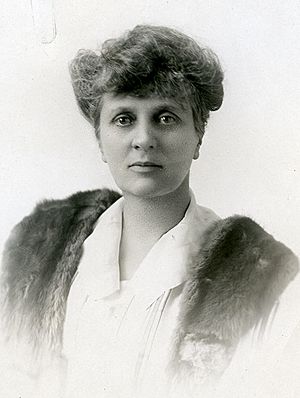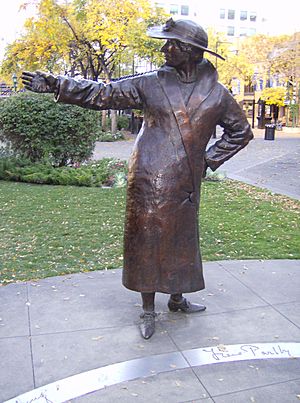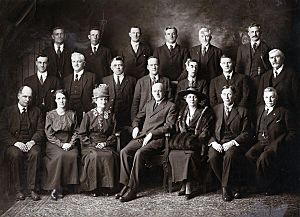Irene Parlby facts for kids
Quick facts for kids
Irene Parlby
|
|
|---|---|
 |
|
| Member of the Legislative Assembly of Alberta | |
| In office 1921–1935 |
|
| Preceded by | Andrew Gilmour |
| Succeeded by | Duncan MacMillan |
| Constituency | Lacombe |
| 1921–1935 | Minister without portfolio |
| Personal details | |
| Born |
Mary Irene Marryat
9 January 1868 London, England |
| Died | 12 July 1965 (aged 97) Red Deer, Alberta, Canada |
| Political party | United Farmers |
| Spouse |
Walter Parlby
(m. 1897; died 1951) |
| Children | 1 |
| Occupation |
|
Irene Parlby (born Mary Irene Marryat; 9 January 1868 – 12 July 1965) was an important Canadian leader, activist, and politician. She fought for the rights of women, especially those living on farms.
Irene Parlby was a member of the Legislative Assembly of Alberta from 1921 to 1935. During this time, she was a Minister without portfolio in the Alberta government. This meant she was a minister but did not have a specific department to lead. She worked hard to create social reforms that helped farm women and children. She also supported public health programs.
Parlby was one of the "Famous Five". This group of five women fought for women to be recognized as "persons" under the law. This allowed women to serve in the Senate of Canada. They took their case all the way to the highest court in the British Empire. From 1930 to 1934, she also represented Canada at the League of Nations in Geneva, Switzerland.
Irene Parlby received many awards for her work. In 1935, the University of Alberta gave her an honorary law degree. She was the first woman to receive this honor from the university. In 1966, she was named a Person of National Historic Significance in Canada. In 2009, the Senate of Canada made Parlby and the other Famous Five members Canada's first honorary Senators.
Contents
Early Life and Moving to Canada
Irene Parlby was born Mary Irene Marryat in London, England, on January 9, 1868. She was the oldest of eight children. Her father worked for the Royal Engineers. Because of his job, Irene lived in India for six years during her childhood.
Her family was from the upper middle class. She and her siblings were taught at home by governesses. Irene loved writing and acting. She would create plays for her family and friends. She received a good education, studying music and elocution (public speaking). She was interested in theatre, but a career in acting was not considered proper for women of her social standing back then.
In 1884, when Irene was 16, her family moved back to England. They rented a farm in Limpsfield, Surrey. Irene enjoyed her social life, but she felt her life lacked purpose. She later said she was "killing time as pleasantly as possible".
In 1896, a family friend invited Irene to visit her in the Northwest Territories (which is now Alberta). Irene was 28 years old when she left for Canada in May 1896. Soon after arriving, she met Walter Parlby, who had studied at Oxford. They got engaged in the autumn of 1896. They later built a house near Alix, Alberta. In 1899, while visiting family in England, Irene gave birth to their son, Humphrey.
Political Career and Achievements
Irene Parlby's political journey started in 1914. She and other women in her area formed the Alix Country Women's Club (ACWC). Parlby was chosen as the secretary. One of their first achievements was creating a local library. This was one of the first libraries in the province.
In 1915, the United Farm Women of Alberta (UFWA) was created. This group was connected to the United Farmers of Alberta. The ACWC became the first local branch of the UFWA. The next year, Irene Parlby was elected as the first president of the UFWA. Between 1918 and 1920, the group grew from 1,450 to 4,000 women. As president, Parlby worked to improve healthcare. She helped set up local hospitals. In 1920, she stepped down as president. She felt the organization was strong enough to continue without her.
In the 1921 Alberta general election, Parlby decided to run as a candidate for the area of Lacombe. To her surprise, she won! She described the campaign as "nasty" because she faced harassment for being a woman. The United Farmers party won 38 out of 61 seats across the province. This gave them control of the Legislative Assembly of Alberta.
Herbert Greenfield became the Premier (leader of the province). Parlby was chosen to be a Minister without Portfolio in the government. This made her the second woman in the British Empire to hold a ministerial position. The first was Mary Ellen Smith from British Columbia.
In 1930, Prime Minister R. B. Bennett chose Parlby to be one of Canada's three representatives at the League of Nations in Geneva. She served there until 1934. After her third term in office, she decided not to run for re-election in 1935. However, she remained active in public life. She was a popular speaker, giving talks in person and on the radio.
Throughout her time in government, Parlby worked for many social reforms. She focused on issues important to women and children. She supported immigration. She believed that people from all backgrounds should celebrate their heritage and culture. Parlby introduced many bills. One important bill was the Minimum Wage for Women Act. This made Alberta the first province to set a minimum wage for women. She also tried to pass the Community of Property Act. This bill would have allowed women to own property they brought into a marriage, along with gifts and inheritance. However, this bill did not pass because it was seen as too radical at the time.
The Famous Five and the Persons Case
Irene Parlby was one of the "Famous Five". This group included Henrietta Muir Edwards, Nellie McClung, Louise McKinney, and Emily Murphy. They asked the federal government for women to have the right to serve as senators. This case became known as the "Persons Case".
The federal government argued that women were not considered "qualified persons" under the law at the time. This meant they could not be appointed to the Senate of Canada. In 1927, the case went to the Supreme Court of Canada. The court ruled that women were not eligible for the Senate.
The Famous Five then appealed the case to the Judicial Committee of the Privy Council in London. This was the highest court for the British Empire. In 1929, the Judicial Committee overturned the Supreme Court's decision. This meant women could now serve in the Senate! The first woman appointed to the Senate was Cairine Wilson, the following year.
Later Life and Legacy

In 1935, the University of Alberta gave Irene Parlby an honourary doctorate. This was to recognize her many achievements. She was the first woman to receive this honor from the university.
Irene Parlby passed away on July 12, 1965, in Red Deer, Alberta. She was the last surviving member of the Famous Five.
In May 1966, the Canadian government recognized Parlby as a Person of National Historic Significance. A special plaque honoring her is in Alix, Alberta. In 1997, the Persons Case itself was recognized as a National Historic Event.
In 2000, two identical monuments were created. One is in Calgary, Alberta, and the other is near the Senate of Canada Building in Ottawa, Ontario. These monuments are called Women are Persons!. They show the members of the Famous Five reading the news about their victory in the Persons Case. These monuments were later featured on the $50 banknote in Canada. In October 2009, the Senate voted to name Parlby and the rest of the Famous Five Canada's first "honorary senators".
See also
 In Spanish: Irene Parlby para niños
In Spanish: Irene Parlby para niños



